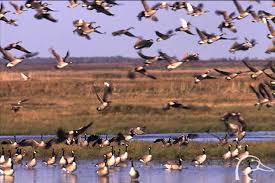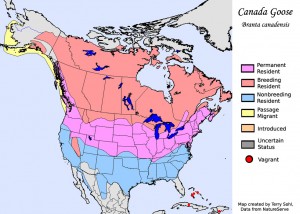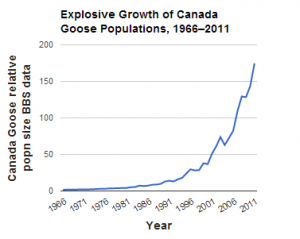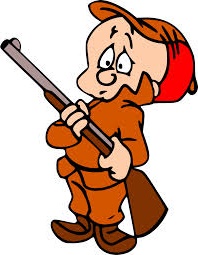The Canada Goose (Branta canadensis), General Biology:



APPEARANCE
The Canada Goose has a black head, neck, legs, tail, and a white chinstrap. They also have a gray-brown body with a cream breast. It is known for being the most widespread goose in North America. Because of their wide geographic distribution, their characteristics also vary based on where they live. Among subspecies, the largest goose in the world resides in the South while one of the smallest resides in the North. Their colors also differ based on these geographic markers, becoming lighter towards the South and in the East and darker in the North and the West. (Mowbray et al., 2002)
They can range from 75 to 110 cm (30 to 43 in) in length and 127–185 cm (50–73 in) in wingspan.
The male Canada goose usually weighs 2.6–6.5 kg (5.7–14.3 lb), and the female is slightly lighter at 2.4–5.5 kg (5.3–12.1 lb).
There are several different subspecies of Canada Goose, of slightly different sizes and colors. The Canada Goose is not to be confused with the Cackling goose, which is a separate species that is very similar looking but smaller, and with darker plumage (Mowbray et al., 2002).
Goose distribution (http://www.sdakotabirds.com/species/maps/canada_goose_map.htm)
SOCIAL BEHAVIOR
Canada Geese associate in large flocks for most of the year. Usually, many birds in these flocks are related to one another. They are considered very social birds except during the mating period when the males become aggressive towards strange birds (Mowbray et al., 2002)
Offspring remain with their parents for first year of life and travel in flocks with them. Mated pairs of geese break away from their flocks in the springtime and begin to stake out a territory. The spacing of nests can vary depending on population density and nest availability. Canada Geese may fight and compete over territory as well as food (Mowbray et al., 2002)

Beginning an attack (http://tri-statewildlifemanagement.com/category/canada-goose-removal-2/)
BREEDING BEHAVIOR
Canada geese mate in monogamous pairs that are usually formed during the second year of life and last until death. Geese mate “assortatively”, which means that the birds will choose mates of similar sizes. Young geese will often remain with their parents for a full year. (Mowbray et al., 2002)
Females usually nest individually or semi-colonially and try to make nests near bodies of water out of sticks, grass, weeds, and down. The geese prefer to make nests in small islands where there is plenty of water available and good visibility to keep offspring out of danger from predators. The female incubates while the male protects her and the eggs from danger. Additionally, females tend to show a preference to returning to the natal area to build her nest and lay 2-8 eggs. Canada geese reach their peak breeding output at four to five years old. (Mowbray et al., 2002)
(http://www.worldanimalfoundation.org/ducks–geese.html)
(Graph shows recent increase in Canada Goose Population-http://blog.allaboutbirds.org/2013/09/17/canada-goose-resident-vs-migratory/)
HABITAT AND FORAGING
The Canada Goose is the most wide spread goose in North America. It is primarily a ground forager, and prefers flat, featureless tundra, boreal forest, prairies and parklands, and high mountain meadows. They are particularly drawn to areas near water, and flat areas such as grassy lawns or grain fields. Canada geese are either migratory or sedentary. Those that live in more temperate climates tend to be sedentary, while those who live in more seasonal climates migrate South for the winter. They are, however, only partially migratory, only traveling for short distances in the distinct V pattern. (Mowbray et al., 2002)
The Canada Goose forages on grasses, sedges, and berries during breeding season, and on grasses and agricultural crops during the winter.
They are almost exclusively herbivorous. Post fledglings rely on berries and seeds for the higher carb content. Canada Geese feed diurnally, which means during the day, although they will eat at night if they feel threatened during the day. The bill of the Canada Goose does not suit feeding on below ground plants. (Mowbray et al., 2002)

Canadian Geese Flock
(https://web.duke.edu/nicholas/bio217/ekc7/geese.htm)

(https://www.youtube.com/watch?v=m8cWrsyJQto)
Citations:
All About Birds. The Cornell Lab of Ornithology. Web. 7 April. 2015.
Mowbray, Thomas B., Craig R. Ely, James S. Sedinger and Robert E. Trost. 2002. Canada Goose (Branta canadensis). In The Birds of North America, No. 682 (A. Poole, Ed.). The Birds of North America Online, Ithaca, New York.
Manning, T. H. 1978. Measurements and weights of eggs of the Canada Goose, Branta canadensis , analyzed and compared with those of other species. Can. J. Zool. 56: 676–687.
USGS Patuxent Wildlife Research Center. 2011. Longevity records of North American Birds.





wow, that’s really great bird! i really wanna see it in front of my eyes.